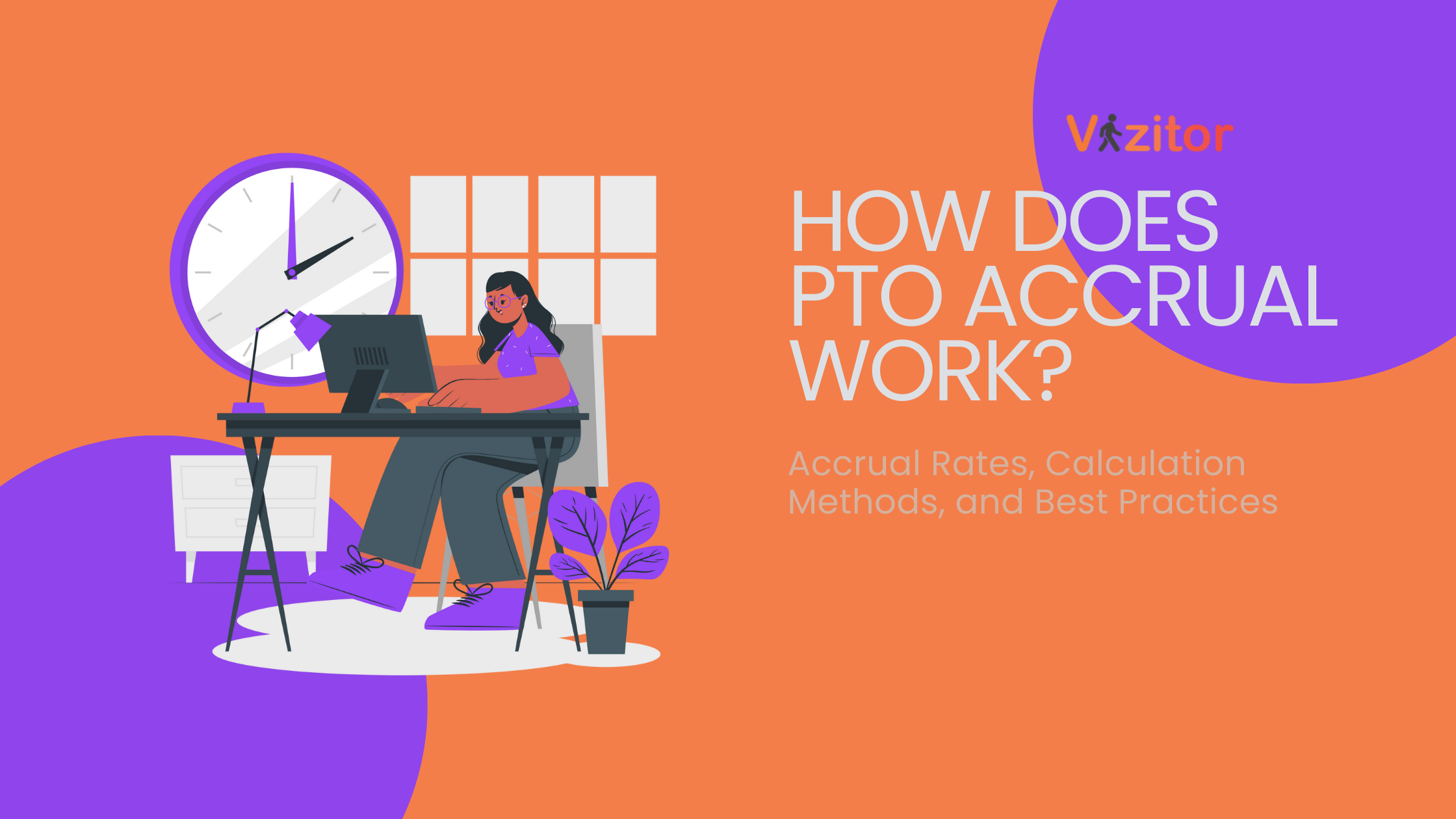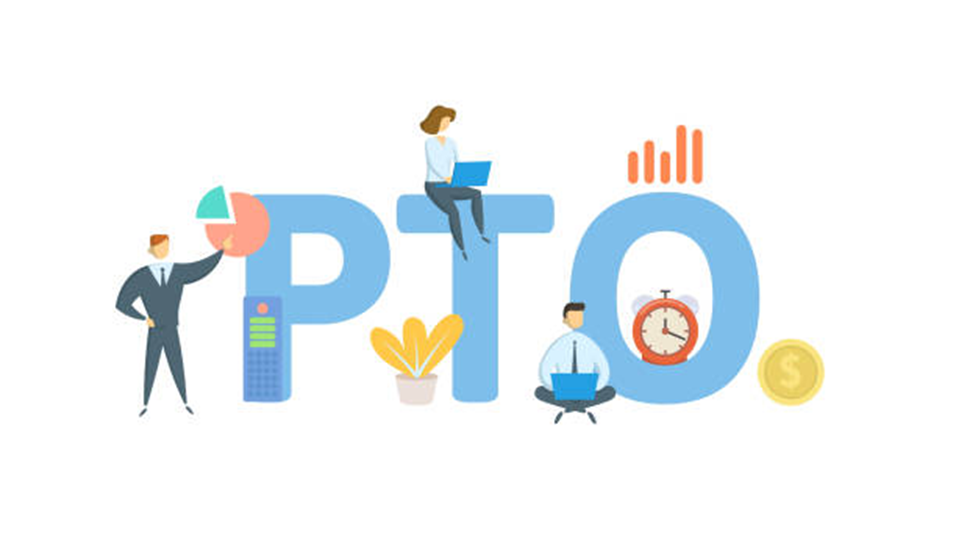Table of Content
Try Vizitor for Free!

Mon, Jun 17, 2024
Read in 11 minutes
Why PTO Accrual Is Essential for Modern Businesses
In today’s fast-paced work environment, Paid Time Off (PTO) accrual has become a vital component of employee well-being and productivity.
The PTO accrual system allows employees to gradually earn time off based on their hours worked or length of service, ensuring fairness and flexibility.
Companies like Google, Microsoft, and HubSpot have pioneered progressive PTO policies, demonstrating that prioritizing employee time off leads to better retention, reduced burnout, and increased productivity.
But how does PTO accrual work, and is it the right approach for your business?
Let’s break it down, explore its benefits, and learn how to calculate PTO accurately.
In this guide, we’ll cover:
- What PTO accrual is and how it works.
- Key benefits of PTO policies for your business.
- PTO accrual calculation examples.
- Best PTO tracking tools to automate leave management.
Let’s transform your company’s approach to paid time off.
What is PTO Accrual?
PTO accrual refers to the process of gradually earning paid time off based on the hours you work. Different companies have different policies, but generally, the more hours you work, the more PTO you accumulate. This accrued time can then be used for various types of leave, such as:
Vacation days: Enjoy time away from work to relax and travel.
Sick leave: Take time off to recover from illness without financial impact.
Personal days: Address personal needs or emergencies.
Paid Time Off (PTO) accrual is a system that allows employees to earn and accumulate leave time based on the number of hours they work or their length of service with a company. Instead of granting a set number of days off at the beginning of the year, employees accrue PTO gradually, typically with each pay period. This approach ensures a fair and systematic way for employees to earn their time off, aligning their leave entitlement with their contribution to the organization.
How Does PTO Accrual Work?
Key Components of PTO Accrual:
| Factor | Explanation |
|---|---|
| Accrual Rate | Employees earn PTO based on work hours (e.g., 1.5 hours per 40 hours worked). |
| Carryover Policy | Some companies allow PTO rollover, while others have a “use it or lose it” rule. |
| Accrual Cap | A limit on maximum PTO hours an employee can accrue. |
| Usage | PTO is used for vacations, illness, or personal reasons, based on company guidelines. |
Example PTO Accrual Calculation:
If an employee earns 1.5 hours of PTO for every 40 hours worked:
- Works 80 hours in a pay period → PTO Earned: 1.5 x 2 = 3 hours.
- For salaried employees: 120 PTO hours annually / 24 pay periods = 5 hours per pay period.
Common Challenges with PTO Accrual
Even the best PTO policies can face challenges. Here’s how businesses struggle and what you can do to fix it:
| Challenge | How It Affects Business | Solution |
|---|---|---|
| Manual Tracking Errors | Leads to miscalculations and disputes with employees. | Use PTO tracking software like Vizitor AMS to automate accruals. |
| Low PTO Usage | Burnout & reduced morale as employees avoid taking leave. | Encourage PTO usage, promote work-life balance openly. |
| Overlapping Leave Requests | Operational disruption if key staff are off simultaneously. | Create a structured approval workflow to manage leave better. |
| Unclear PTO Carryover Policy | Employee dissatisfaction due to confusion over unused PTO. | Clearly communicate policies via handbooks & HR platforms. |
Is Paid Time Off Right For Your Business?
Implementing a Paid Time Off (PTO) policy is a significant decision that can impact various aspects of your business, from employee satisfaction to overall productivity. Understanding whether PTO is right for your business involves evaluating its potential benefits, challenges, and how it aligns with your company’s culture and operational needs.
Benefits of Implementing PTO
Enhanced Employee Well-being: PTO allows employees to take necessary breaks to recharge, leading to improved mental and physical health. This can result in higher levels of job satisfaction and reduced burnout.
Increased Productivity: Well-rested employees are more focused and productive. By ensuring your team has the opportunity to take time off, you can maintain a high level of efficiency and performance.
Attracting and Retaining Talent: A competitive PTO policy can be a strong selling point when recruiting new talent. It demonstrates that your company values work-life balance, which can help retain current employees and attract top candidates.
Flexibility and Autonomy: PTO provides employees with the flexibility to use their time off as they see fit, whether for vacations, personal matters, or illness. This autonomy can boost morale and foster a sense of trust and respect between employees and management.
Consider the example of HubSpot, a company known for its strong culture and employee benefits. HubSpot offers unlimited PTO, allowing employees to take as much time off as they need, provided their work is covered and their manager approves.
This policy has contributed to HubSpot’s high employee satisfaction rates and has positioned the company as a desirable employer, helping attract top talent and reducing turnover.
Step In Implementing Paid Time Off
Implementing a Paid Time Off (PTO) policy involves careful planning and clear communication to ensure it aligns with your company’s goals and meets the needs of your employees. Here are the key steps to successfully implement a PTO policy:
1. Define Your PTO Policy
Determine the Structure: Accrual vs. Lump Sum: Decide if employees will accrue PTO over time or receive a lump sum at the beginning of the year.
Annual Allowance: Set the number of PTO days employees are entitled to each year, considering factors like industry standards and company size.
Types of PTO: Define what PTO can be used for, such as vacations, personal days, and sick leave.
Eligibility: Establish who is eligible for PTO, including full-time, part-time, and temporary employees.
2. Develop Clear Guidelines
Accrual Rate: Specify the rate at which PTO is accrued (e.g., 1.5 hours per 40 hours worked).
Carryover and Cap Policies: Determine if unused PTO can be carried over to the next year and if there is a cap on the maximum amount of PTO that can be accrued.
Request and Approval Process: Outline the process for requesting PTO, including how far in advance requests should be made and how approvals will be handled.
3. Ensure Compliance
Legal Requirements: Research and comply with local, state, and federal laws regarding paid leave to ensure your policy meets all legal requirements.
4. Communicate the Policy
Employee Handbook: Include the PTO policy in the employee handbook, providing detailed explanations and examples.
Training Sessions: Conduct training sessions for managers and employees to explain the policy, answer questions, and address concerns.
Ongoing Communication: Regularly remind employees of their PTO balance and encourage them to take their entitled leave.
5. Implement a Tracking System
Software Solutions: Invest in HR software or a PTO tracking system to automate accrual calculations, track usage, and manage requests.
Manual Tracking: If software is not an option, develop a reliable manual tracking method to ensure accurate record-keeping.
6. Monitor and Evaluate
Regular Reviews: Periodically review the PTO policy to ensure it remains effective and fair. Gather feedback from employees and managers to identify areas for improvement.
Adjustments: Be open to making adjustments based on feedback and changing business needs
7. Promote PTO Usage
Encourage Time Off: Foster a culture that values work-life balance by encouraging employees to use their PTO. Highlight the benefits of taking breaks for personal well-being and productivity.
8. Plan for Coverage
Cross-Training: Train employees to cover for each other’s roles to ensure business continuity during absences.
Scheduling: Develop a scheduling system that allows for adequate coverage while accommodating PTO requests.
How To Calculate PTO
Calculating PTO (Paid Time Off) involves determining how much time off employees have earned based on your company’s PTO policy. Here’s a step-by-step guide to help calculate the number of PTO Hours for your employees:
1. Determine the Accrual Rate
Hourly Accrual Rate: Decide how much PTO employees will earn per hour worked. For example, if employees earn 1.5 hours of PTO for every 40 hours worked, this is your accrual rate.
Annual Accrual Rate: If you prefer to calculate PTO on an annual basis, determine the total number based on the number of PTO hours an employee earns in a year. For instance, if an employee earns 120 hours of PTO per year, divide this by the number of pay periods to find the per-period accrual rate.
2. Establish the Calculation Method
Hourly Employees: Multiply the number of hours worked by the accrual rate. For example, if the accrual rate is 0.0385 hours of PTO per hour worked (1.5 hours/40 hours) and an employee works 80 hours in a pay period: PTO Earned = 80 hours worked x 0.0385 = 3.08 hours of PTO
Salaried Employees: Divide the total annual PTO by the number of pay periods. For example, if an employee earns 120 hours of PTO per year and there are 24 pay periods: PTO Earned per Pay Period = 120 hours / 24 pay periods = 5 hours of PTO per pay period
3. Account for Partial Pay Periods
If an employee starts or ends employment in the middle of a pay period, prorate the PTO based on the number of days worked. For instance, if an employee works 10 days in a 20-day pay period and the accrual rate is 5 hours per pay period: PTO Earned = (10 days / 20 days) x 5 hours = 2.5 hours of PTO
4. Include Carryover and Cap Policies
Carryover: Determine if unused PTO can be carried over to the next year. If so, add the carryover hours to the current year’s accrual.
Cap: Ensure the total accrued PTO does not exceed the maximum cap set by your company. If an employee reaches the cap, they stop accruing additional PTO until they use some of their accumulated time.
5. Use a PTO Calculator Tool
Consider using an HR software or a PTO calculator tool to automate the accrual process. This reduces the risk of errors and simplifies tracking.
6. Communicate with Employees
Regularly inform employees about their accrued PTO balances. This transparency helps employees plan their time off effectively.
Example Calculation
Scenario: An hourly employee works 80 hours in a pay period. The accrual rate is 1.5 hours of PTO per 40 hours worked.
Calculation: PTO Earned = 80 hours worked x (1.5 hours / 40 hours) = 3 hours of PTO
Annual Calculation for a Salaried Employee: An employee earns 120 hours of PTO per year.
There are 24 pay periods in a Calendar Year.
Calculation: PTO Earned per Pay Period = 120 hours / 24 pay periods = 5 hours of PTO per pay period
Top Tools to Track PTO Accrual in 2025
The right tools simplify PTO management, ensuring accurate accruals and timely approvals:
| Tool Name | Key Features | Best For | Website |
|---|---|---|---|
| Vizitor AMS | PTO accrual, time tracking, leave requests, payroll | Small to Mid-sized businesses | Visit Site |
| BambooHR | Employee self-service, PTO balances, reports | Growing teams | Visit Site |
| Gusto | PTO tracking, payroll integration | Startups & Small Businesses | Visit Site |
| Zoho People | Leave calendar, mobile leave requests | Remote & Hybrid Workplaces | Visit Site |
| ADP Workforce | PTO automation, compliance tracking | Large Enterprises | Visit Site |
Easily Track PTO Accrual With Vizitor

At Vizitor, we believe in offering a fair and transparent PTO policy. Here’s how our PTO accrual system works:
Accrual rate: Your PTO accrues at a specific rate per pay period based on your full-time or part-time status and position.
Accrual period: PTO accrues throughout the year, allowing you to accumulate days for future use.
Carried over time: Unused PTO may be carried over to the next year, subject to company policy.
For specific details regarding your accrual rate and carry-over policy, please refer to your employee handbook or consult the HR department.
Vizitor Attendance Management System:
Vizitor not only excels in providing transparent PTO benefits but also offers a comprehensive Attendance Management System (AMS). This innovative system facilitates:
Efficient clock-in and clock-out: Streamline your timekeeping process with various clocking options, including mobile app, physical kiosk.
Detailed attendance reports: Access real-time and historical data on employee attendance, enabling accurate payroll processing and informed decision-making.
Leave management: Manage PTO requests and approvals seamlessly within the system, ensuring a smooth and efficient leave process for both employees and managers.
Frequently Asked Questions
How Does Accrued Paid Time Off Work?
Accrued Paid Time Off (PTO) works by allowing employees to earn PTO incrementally based on the hours they work or their tenure with the company, accumulating over time.
Are Accrued Time Off and Outstanding Time Off the Same?
No, accrued time off is the PTO earned but not yet used, while outstanding time off typically refers to the total PTO balance available, including both accrued and unused time.
What’s the Difference Between Lump-Sum and Accrued PTO?
Lump-sum PTO is granted all at once at the beginning of a period, while accrued PTO is earned gradually over time based on hours worked or length of service.
How does PTO Accrue for full-time employees?
Full-time employees usually accrue PTO based on the company’s accrual policy, which might be per hour worked, per pay period, or annually.
What happens to PTO hours when an employee leaves the company?
When an employee leaves the company, accrued but unused PTO hours may be paid out, depending on the company’s policy and local labor laws.
How do you calculate the number of PTO hours an employee has?
To calculate the number of PTO hours, multiply the employee’s accrual rate by the total number of hours worked or the duration of their employment.










